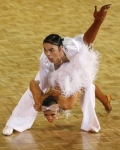
Originally known as the cha-cha-cha.
became popular about 1954.
Cha Cha Dance is an offshoot of the Mambo. In the Mambo. Ultimately it evolved into a detach dance, known today as the Cha Cha. The dance is of three rapid steps and two slower steps on the one beat and two beat.
In the late 1940s, Havana, Cuba, was one of the most popular resorts for North Americans, especially those residing along the east coast. The most famous American dance bands as well as the many outstanding Latin bands native to Cuba played at the city's casinos. Some of these orchestras tried combining the American JAZZ beat with the Cuban RUMBA rhythm Dance; The result was a new rhythm called the MAMBO.
A dance was developed to the new mambo rhythm, danced to the off beat rather than the traditional downbeat. For this reason, the dance was popular mainly with dancers thoroughly familiar with complex Afro-Cuban music. However, among the many figures of the mambo was one called the "chatch", which involved three quick changes of weight preceded by two slow steps. By the early 1950s, this figure had developed into a new dance comprised of many simple variations on the basic footwork. The dance acquired the name CHA-CHA ; its characteristic three-step change of weight carried the identifying verbal definition, "cha-cha-cha".
The cha-cha inherited much of its styling from its parent dances, the rumba and the mambo. Like most Latin dances, it is done with the feet remaining close to the floor. The dancers' hips are relaxed to allow free movement in the pelvic section. The upper body shifts over the supporting foot, as steps are taken.
The "Cha Cha" is danced currently at about 120 beats per minute. The steps are taken on the beats, with a strong hip movement as the knee straightens on the half beats in between. The weight is kept well forward, with forward steps taken toe-flat, and with minimal torso movement. The chasse on 4&1 is used to emphasize the step on beat 1, which may be held a moment longer than the other steps to match the emphasis of the beat in the music.








